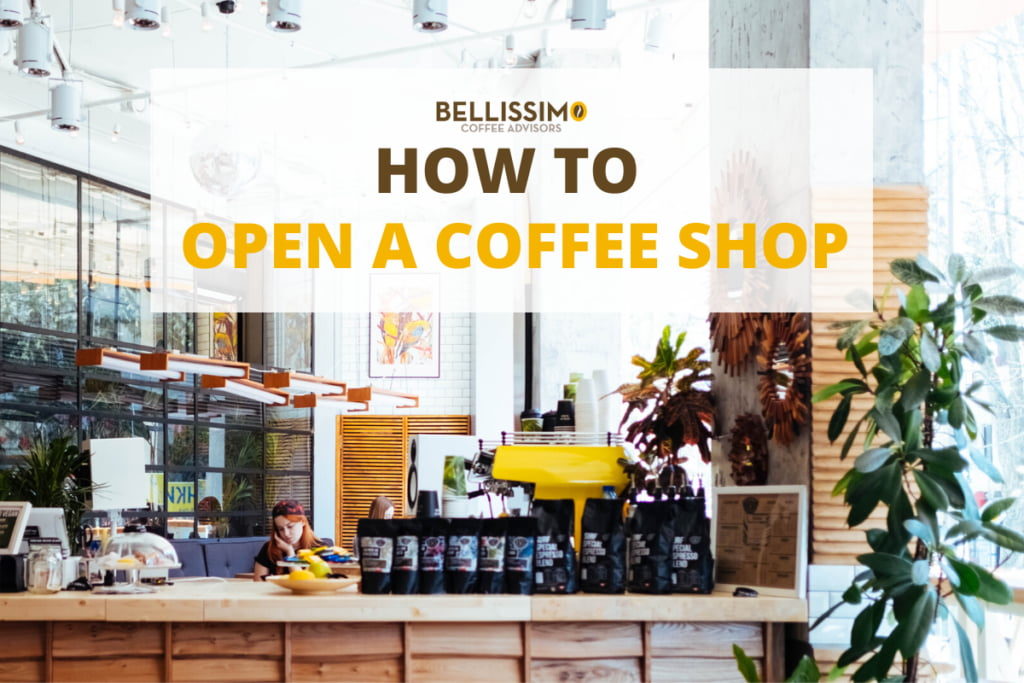If you’re looking for the definitive guide to opening a coffee shop in 2020, this is it.
Our business is built entirely on the foundation of “Helping People Succeed in Specialty Coffee”. In short, this is what we do. We help people open coffee shops, and help people who own coffee shops run them to be more efficient and profitable. This is our niche.
If you’re in the beginning phases of opening a coffee shop, or already own one and are looking for ways to improve it – you are our target audience. We exist solely to help YOU.
It’s what our company has been doing for over 30 years, and what we have done for thousands of coffee shops worldwide in that time span.
We’re based out of Portland, Oregon. One of the most competitive coffee markets in the world. Within this market, we run two successful coffee shops and one of the top selling roasteries in the Pacific Northwest. In short, we walk the walk and talk the talk.
Being cafe and roastery owners ourselves helps us to remain in touch with the needs of our customers, and gives us the understanding of what we need to do in order to serve them best.
This guide is designed to help anybody looking for help with the question, “how to open a coffee shop and how to do it the right way, the first time.”
Before you spend another dollar on your business, we strongly encourage you to read this guide, take notes, and get back to us with anything you need clarified. We’re here to help.
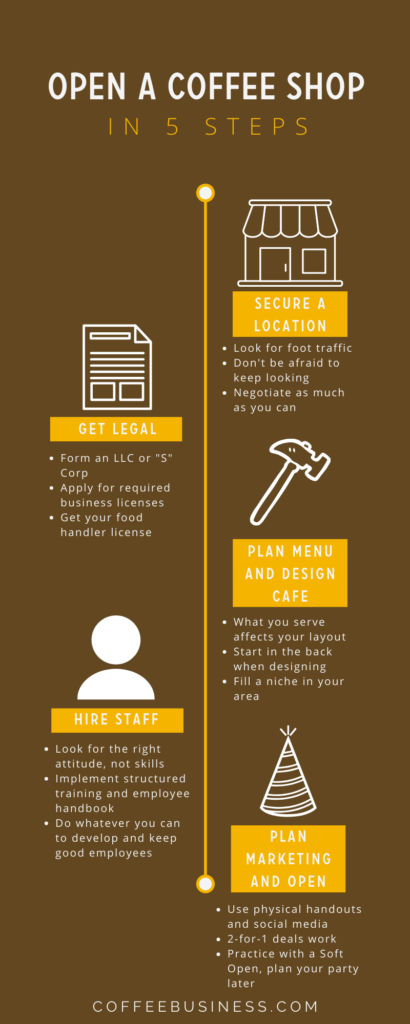
Develop an Airtight Business Plan
One of the most common questions we get is: “Do I need a business plan?”
The answer is usually… it depends.
Usually when someone asks this question, they’re talking about a fully fleshed out financially-deep, written business plan – the type that you’d take to a bank during the startup phase while securing investors or a loan. While that’s useful if you’re trying to secure a large loan from an investor (and wise to consider finances in the long-term), the type of business plan we believe to be most beneficial in the early stages of opening a coffee shop? It’s more of a general gameplan and guideline that helps you understand how you position yourself in a competitive market, what makes you stand out, the brand identity you need your employees to embody, and so on.
All businesses start with an idea. Maybe your idea is entirely unique; you’ve never seen anything like it anywhere. Maybe your idea isn’t entirely unique, but it IS unique to your area. Whether you want to open a large cafe or a coffee cart, you need a game plan.

Your business idea and plans can run the gamut, but without a plan, it will likely always be just that. An idea. A perfected business plan brings life to your ideas, and forces you to consider everything you need to consider in order to both show others how seriously you’re taking your dreams, but also to provide a roadmap to follow throughout the life of your business. A business plan shows that you’re serious about what you want to do, you’ve done your homework, and gives structure to an otherwise intangible idea. It’s the road map that gets you from A to Z.
But where do you get started? Some people may have gone to business school to prepare for this moment, but a great majority of our customers haven’t.
That’s where our business plan comes in. More than anything else, it is to keep you and anyone you work with organized and focused on your goals, understanding their role in the grand scheme of things. When starting a business, the best advice for starting out is that you always want to fill a niche. You need to fully understand the needs of your future customers. Are you positioned in a bustling downtown area full of people coming and going to work? Maybe you don’t need a large space with a lot of seating. But if you’re near a college, for example, you WILL need lots of tables, couches, and chairs (and outlets for people to charge their laptops at!). Keeping your business plan flexible allows you to address the unique needs of whatever location you decide to go for. Your location and ideal customer can’t be ignored even in the early planning phase.
If you’re looking to be one of the first coffee shops in your area and without much competition, you might be able to get away without a structured plan. But if you’re looking to open a coffee shop in a competitive market – you will need to have a truly original idea, and to understand your audience as best as humanly possible. THAT is how you’ll get customers coming through your doors, day in and day out. A good business plan helps guide you towards success by forcing you to think about important details that may not be obvious at first.
One tip – you may find your concept changing as you work through your business plan – that’s normal! You may even find out your idea just doesn’t make sense on paper. You can theoretically spend lots of time and effort on something only to find that your idea isn’t working out half way through – it can be demoralizing, but working through a business plan makes sure you’re not investing thousands of dollars in an idea that’s doomed from the start. At the end of the day, it’s better to lose a little bit of time and effort than potentially delve into a big, expensive business endeavor that never had much of a chance to begin with. Working through these things sets you up for success when you finally do have that winning idea and location.
The bonus of a business plan is you can use it to secure investors, create interest, and convince your family and friends that your idea isn’t just a pipe dream. It also functions as your basis for training and getting your employees as passionate about your shop as you are. Having a business plan conveys you’re serious about what you’re trying to do.
Building a good business plan requires a lot of time and effort. In the early days of Bellissimo, one of our most popular services was creating business plans for coffee shops, much like ours. Over time, we began to realize there were a lot of consistencies showing up from coffee shop to coffee shop. Shop owners would routinely ask the same questions, or want the same things in theirs. We would charge multiple thousands of dollars for these business plans, and our business plans eventually grew to be such a unique item, we decided to pivot our strategy into the concept of “let’s templatize this business plan, make it more affordable, and make it available to a wider audience.”
In doing this, we were able to utilize the internet in a way that we couldn’t before, and get our tried and true, battle tested coffee shop business plan in the hands of soon-to-be coffee shop entrepreneurs around the globe. By lowering the price to a meager $695 (rather than the thousands we used to charge for one-on-one plan writing), we have been able to expand our reach, and streamline the process for thousands on their way to coffee shop success.
If your coffee shop does not currently possess a streamlined, developed business plan, we encourage you to check ours out.
Find the Perfect Location
Finding the right location is possibly the most important thing a potential coffee shop owner can do. Without the right location, everything else you do is potentially wasted effort. After all, what good is excellent coffee, customer service, and an affordable lease if there are no people around to sell your beverages to?
What to look for
Traffic. Traffic and accessibility are your essential needs. Depending on the community that you serve, it can be vehicle traffic (namely if you’re opening a drive thru or have ample parking, but foot traffic is ideal). Through marketing and promotions, you may occasionally attract customers outside their immediate living and working areas, but you will almost never get regulars. That’s why you need to be near as many people as possible. Large office buildings, hospitals, and tourist areas are the most ideal centers to concentrate on. Apartment buildings are not bad either, but generally won’t lead to quite as much business. They sound great in theory, but remember that a majority of people brew their coffee at home, only going out occasionally. It’s unwise to limit your audience to only the people who live in a specific building and bank on them to come down every day.
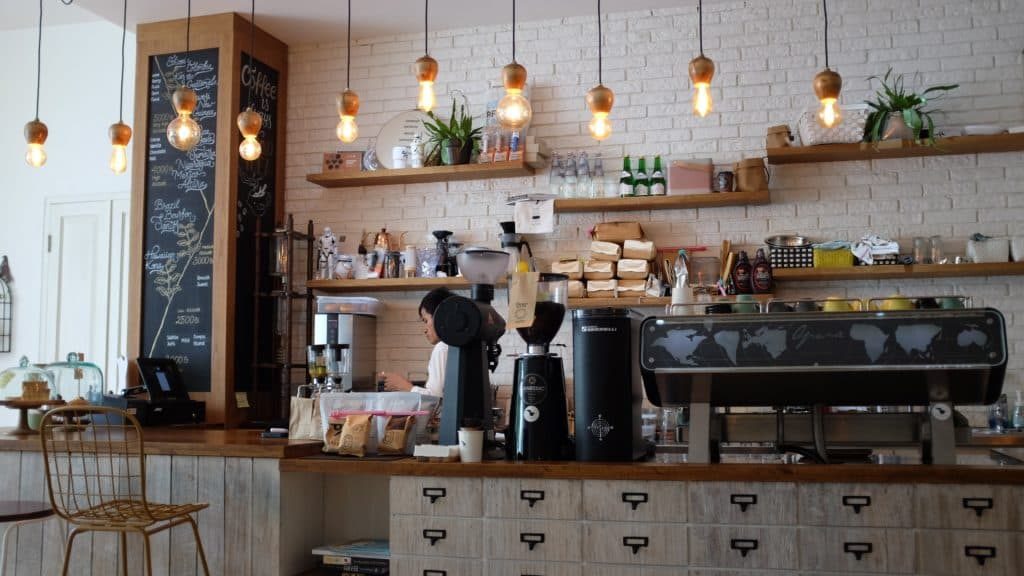
Any location is a balancing act between cost and benefit. The best locations are usually much more expensive, and most coffee shops just have to justify extremely high rent costs. The exception to this is smaller spaces that may be more affordable. They also allow for more customer turnover, and can be a great option for coffee businesses. Namely if your clientele do not need lots of space to sit. Many coffee shops can be hugely successful in a small space due to low overhead and a constant flow of customers.
The last thing that can make or break a location is renovations. It’s tempting to look for a place that was already a restaurant or coffee shop, but that’s not always the best idea because a business already failed there once. At the very least, it’s important to figure out why that business failed and what you can do differently. When looking at locations that aren’t properly vented and plumbed, make sure to factor in that cost (or talk to the landlord about doing it) because it can quickly turn into a massive investment.
Cafe Locations vs Coffee Cart Location
Both cafes and coffee carts want similar things out of a location. Foot traffic is essential, as well as visibility. However, because coffee carts are smaller and have less overhead, they are more flexible with where they can be placed. Mobile coffee carts also have he benefit of changing locations depending on where the best market is. Cafes are a bigger investment with a potentially bigger profit, but they have to be positioned well. Coffee carts are a little more forgiving when it comes to initial investment and location, so they are a popular entry point into the industry.
How to get your ideal location
Finding your ideal location is one thing, but actually getting it is a whole new challenge. The most important thing to remember is: negotiate! Be able to talk about your business what the benefits of it clearly. Data (even data that isn’t perfect) can help drive your point home. By opening a coffee shop in a space you’re inherently bringing value to whomever owns it, not the other way around. Leverage that idea when negotiating for price and buildout. Don’t forget that things like plumbing and counters are the landlord’s property, so your landlord may contribute to those expenses. Remember, a coffee shop almost ALWAYS brings up the value of a neighborhood and adds significant foot traffic to any shopping center. They are seen as valuable community meeting spaces, and homes within walking distance of a coffee shop are more desirable. The very nature of you bringing your business to a neighborhood should be seen as a huge plus to any landlord. However, don’t assume that every landlord will automatically understand the value your business can bring, so it’s up to you to help them understand what they stand to gain by leasing to your business and helping you with your buildout.
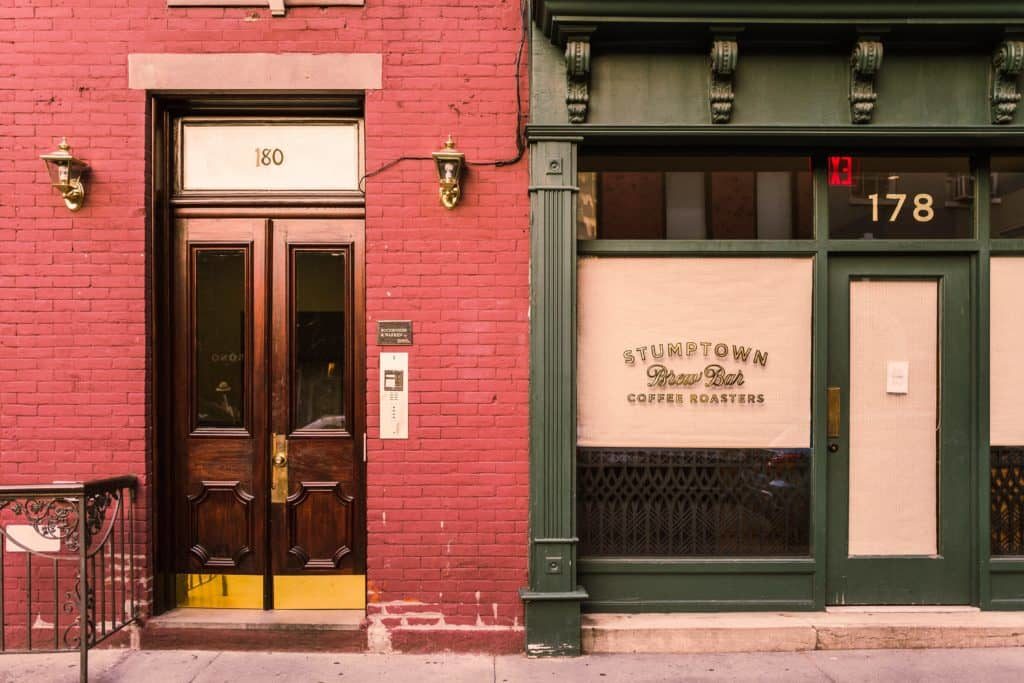
Develop Essential Skills
Barista Skills
Plenty of people with varied backgrounds or entrepreneurial spirits want to open a coffee shop even if they’ve never worked in one, and that’s fine! Strictly speaking, you don’t need to have been a barista to open a coffee shop, but it really helps. A part time barista job while you work on your coffee bar can at least get you started with the knowledge you’ll need. Not being able to jump behind the bar or train employees yourself can be a huge disadvantage when opening a new coffee business. You’re guaranteeing the need for a partner or a skilled manager, and then relying on their schedule for any other employees. You also won’t be as informed when it comes to the products you offer because you won’t have the firsthand knowledge of creating them and seeing how customers react.
Certainly, you could work as a barista for a period of time; many people do. Working as a barista is a great method to see if a coffee shop environment is right for you. You learn the skills, get practice working with a team, and when it comes time to hire employees you have a better idea of what to look for, but if you want those skills without having to work for a few years, we have a solution for you.
By investing in your barista education and training, you naturally improve your ability to train your future employees. Remember, even your best baristas will likely not work for you forever. It is up to YOU to be able to train future employees to be able to provide consistently great products that keep your customers returning happily over and over again.
Business Skills
Maybe you’re in the opposite position: you’ve been a barista and want to open up your own shop. Barista skills are vital, but a coffee shop needs a lot more than that to run well. Here are some of the business skills you’ll need to be confident in:
Negotiation
We talked about the importance of lease negotiation before, but that’s not the end of it. Opening a coffee shop is expensive, and paying sticker price for everything is often just not feasible. Negotiation doesn’t have to be hard and you don’t have to be pushy. These strategies are sometimes effective, but they sometimes aren’t.
The most tried and true method of negotiation is being able to assess and communicate value.
It might be your business’s value to someone else (like a landlord), or it might be a machine’s value to your business. In business, everyone is looking to get as much as they can, but everyone understands this. That’s why this value language is universal. Communicating benefits when talking about your own value and communicating challenges when buying are should help to get negotiations started off correctly.
In day one of our five day workshops on how to start a coffee business, we spend a good amount of time teaching negotiation tactics and techniques for ways to convince landlords that your business is worth investing their time and resources in. With just a few simple techniques and concepts worth understanding, we have seen our students negotiate up to 3 years of free rent in a new building for their cafes, or negotiated with landlords to do their entire buildout (saving them tens of thousands of dollars in renovations). The return on investment from one of our workshops often can pay off ten fold.
Networking
Network early and network often.
You never know who might become a valued partner or a customer. It’s no secret that a lot of people drink coffee. It’s also obvious that to many consumers who don’t have developed palettes, there are plenty of options for “good” coffee. It’s easy to pick out bitter, sour coffee, but identifying the subtle nuances of coffee beyond it just tasting better is beyond many people, so having a coffee shop that stands out for other reasons helps bring in customers. One way to stand out and start networking is by being present on the floor and in your community. Humans are communal creatures; we like seeing other humans. If we associate a face with a business instead of just a brand, we are far more likely to want to return to that business.
Additionally, word of mouth is one of the most powerful means of getting new customers. By grabbing the attention of one person, you might also grab the attention of their friends and family. This goes a long way towards building up your shop as a real member of a community. Once you’ve attained that status, you know your networking is succeeding.
And never underestimate the power of reviews. They say that a negative review reaches five times the amount of people than a positive one. By being present in your business, you can drastically improve the amount of control you have in ensuring your customers have a positive experience (and your employees can learn from your example of how they should best interact with customers, a double win!)
Hiring
Nearly every coffee business is going to need an employee at some point, so this is a skill you’ll need. The most important advice we can give when it comes to hiring is to focus on personality and attitude instead of skills. Ask interview questions like:
- How would your supervisor and co-workers describe you?
- Give me an example of a time at work when you went above and beyond what was asked of you.
- Tell me about a difficult situation at work, how you got through it, and what you learned.
Bar skills can always be taught, but finding someone willing to go the extra mile with customers and for your business is nearly impossible to teach. Like we say above, good coffee is subjective to most customers, but good service is something they’ll remember. With every customer, you’re looking to make your coffee shop their coffee shop, and not everyone can do that. Of course, finding the right employees is only the first step.
Managing
Unless your pockets are very deep, you likely will not be able to afford hiring a qualified manager in the beginning phases of your cafe. It is imperative that you possess management skills, or can learn. Good management is not as simple as “being the boss”. As a manager, respecting and valuing your employees is first and foremost. Just making demands is the fastest road to unhappy and underperforming employees.
We all like to feel like we’re part of something, so give your employees opportunities to take part in your business. Encourage them to invent drinks, take pictures for social media, and anything else you can think of for them to take part in and feel valued. Most baristas are multi talented so find out what hobbies your employees have. An artist might be able to contribute to a unique menu while a photographer might be able to take pictures for your website. It’s important to remember that even your best employees will likely not be with your company many years down the road. (of course, if they are, then by all means you’ve struck gold. Be sure to reward them) – in general, however, being a barista is typically a pit stop in a persons journey through life and few make it a long term career. Remember that, and appreciate the humanity behind your employees. Let them flourish in ways that show that you respect them, and they’ll reward you by doing a great job of what you expect out of them. Just be sure you make it clear what it is you need from them.

An unavoidable part of managing is conflict. Sometimes it’s employees in conflict with each other, sometimes it’s a conflict between you and an employee. Good management means not letting it get personal and keeping things focused on how to improve performance as an individual and in a team.
Remember, YOUR performance might be what needs improving. Always try your best to stay objective and understand the needs of the business, see what other people see, listen to the feedback you receive even when it might be uncomfortable. Listen to what your employees have to say, or what they might seem unhappy about. Hold monthly meetings and encourage your staff to bring up anything they feel particularly excited or worried about.
Assuming they want to do a good job (most people do), there is probably a reason for certain tasks not getting done right or at all. Listen and brainstorm ways to make processes easier or more streamlined. Help your employees feel heard and use their insight to improve your business.
Treat meetings as a constructive experience, and not a place to allow for complaints. Create a process where everyone can feel like their complaints will be heard and addressed in a constructive way – but meetings are NOT that place. Lots of things can affect people’s performance, and you never know what someone will be going through on a given day. If it’s not personal, it might be something trivial that you can address quickly and easily. Be sure you’re present, and your employees know that you have an open door policy to hear what they have to say.
This doesn’t mean personal things can’t affect performance. Family or health issues are unfortunately common and often affect work performance. A sympathetic manager who makes an effort to understand those situations can mean a lot to an employee and talking through what’s happening can be all that’s needed to get things back on track.
Budgeting & Inventory
Having an accountant in your corner can be a big help, but they can’t do everything for you. You also might not be able to fit an accountant into your own budget. What then?
Budgeting skills are vital in coffee where transactional profit is often low and inventory can make or break a business. Smart budgeting involves balancing past data with future assumptions to only spend as much money as you need. Budgets are seldom perfect, but being able to create one and develop it through observation is essential.
A big thing that many coffee shop owners will forgo is keeping track of their cost of goods. It is easy to get in the habit of placing your orders and not looking at the invoices, but as your distributors raise their prices, you should too. If the cost of milk goes up, the cost of your lattes may need to go up as well. Otherwise, you’ll start to notice that your profits are quickly disappearing and you may not realize it until your profit is in jeopardy.
Marketing
We’ll cover marketing more in depth below, but it is an essential and unavoidable part of a successful business. Effective marketing starts with outreach, but also includes many more layers to actually bring paying customers in. A new drink, sales, etc. are all ineffective if not marketed well.
“How am I supposed to learn all these things if I’m already working?” You could go to business school, but that path doesn’t make sense or is nearly impossible for many people who want to open a coffee shop. If you want to cut right to the important stuff while spending a fraction of what you’d spend on business school, our 5-day bundle is perfect for you.
Stay Organized
Find Good Partners
You’ll certainly need a good general contractor experienced in cafe/restaurant spaces (more on that later) but what about other partners?
Step one is recognizing your weaknesses. As a business owner, you will have to be good at a lot of things, but no one can be good at everything. There are certain gaps that just can’t be ignored, and it might be wise to hire someone to help you in those areas. Here are four of the most common professionals you might want to look for:
Accountant or Bookkeeper
Money is at the core of any business, so making sure everything is accounted for and accurate is essential. A good accountant/bookkeeper can alleviate a lot of the stress that comes with money and provide some recommendations based on experience. Coffee shop budgets can become complicated quickly, so hiring an accountant to help, even for a short time, is essential.
Business Attorney
You likely won’t need to put a lawyer on retainer, but developing and good working relationship with a business attorney is a worthwhile investment. There are certain things that you will just need a lawyer to look over.
Human Resources Professional
Hiring an HR Professional is not as common as talking to a lawyer, but it should be. HR brings another perspective to your efforts that’s not just about what’s legal (though they can help with that too). By talking to an HR professional, you’re making sure all your employee policies are correct and lawful, and you can feel confident hiring and working correctly with your staff.
Marketer
Getting a good marketing plan early can be a game changer for new businesses. Asking someone with expertise to help you form a long term plan, make contacts, and execute strategies will pay off hugely in the long run. You may want to hire a marketer for a short time to get you started off and again down the line to scale your business up.
Employee Handbook
Most coffee shops will need at least one employee even before they open, so we can not emphasize enough how significant it is to get this done early and correctly. Getting a thorough, clear employee handbook early on helps set expectations and procedures for anyone you work with. A good employee handbook must have the following:
- Defining employees and their relationships with employers
- Standards of conduct for staff
- Team member communications
- Employment Policies
- Salary and Benefits Policies
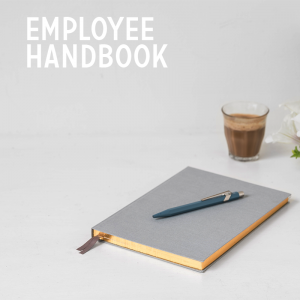
Each of these sections needs to be carefully thought out and written. Once you have a completed handbook, you should also have it reviewed by an HR expert and a lawyer; your handbook can’t just be an afterthought. This document lays out everything you expect of employees and what employees can expect of you. It makes sure everyone is held accountable for what they agree to do. From a legal perspective, you need an employee handbook before one person works one hour for you. Ask any new employee to take time to read the handbook and initial every page. This simple process both makes sure everyone is on the same page as well as saves you from potentially spending thousands of dollars in legal fees. No business owner can afford to get their employee handbook wrong. However, getting this all right takes quite a bit of time and effort. To help new business owners focus on their business, we offer an employee handbook template that comes pre reviewed by legal and HR professionals and is designed to have you ready to go quickly.
Operations Manual
Most prospective business owners know they need an employee handbook, but fewer know about the importance of an operations manual.
Simply put: The employee handbook defines relationships and expectations, but the operations manual tells your employees how to actually do their jobs.
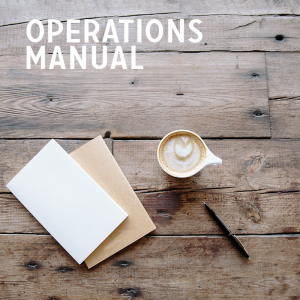
An operations manual is a supplement to on the job training and acts as a reference for employees. It limits your liability by making sure employees know how to consistently make drinks, maintain machinery, and interact with customers. It also provides you and your managers tools to make sure every employee is trained up the same way and to the same standards. No one can blame a barista for not following proper procedure if it was never taught, especially when it comes to complicated equipment maintenance.
You should treat your operations manual as the textbook of your business. It might not be the most exciting or glamorous, but it is vital to making sure your employees feel equipped to do their jobs and consistently give great experiences to customers. An operations manual and an employee handbook work together to communicate policy and make sure your business objectives are clear. Like the handbook, any new hire should sign and date a copy of your operations manual to make sure it is understood.
Want to save even more time? We also offer an operations manual template that has everything your business needs.
Begin Building
How much does it cost to open a coffee shop?
Budgets for new coffee shops can vary especially depending on the equipment you want. To get an idea for what opening a coffee shop costs, here are some general figures:
| Type of Coffee Business | Startup Cost Range |
|---|---|
| Full Cafe/Coffee Bar | $150-$300k+ |
| Coffee Drive-through | $75-250k+ |
| Coffee Cart/Mobile Operation | $20-$75k+ |
One of the biggest expenses in a coffee shop is your initial equipment. Here are some estimates for the big things that you’ll see in most shops.
| Equipment | Typical Cost |
|---|---|
| Espresso Machine | $9000 |
| Grinder | $2800 |
| Coffee Brewer | $2200 |
| Pastry Case | $4800 |
| Undercounter Refrigerator | $1800 |
| Upright Refrigerator | $2500 |
| 3-Compartment Sink | $1100 |
| Dishwasher | $3600 |
It’s not cheap, but being budget conscious can keep things from getting out of control. Buying used equipment is always an option, but try to find out how well the equipment was maintained. Poorly maintained equipment can end up costing more than brand new, and in the long run it can mean terrible value.
Find Funding
Whenever opening any business, doing it with as little debt as possible is ideal. That means your first funding strategy should always be saving your own money. Being frugal can be hard, but it’s a good test to make sure you really want to open a coffee shop. Even after saving money though, chances are you’ll need funding of some kind. Here are some of the safest ways to get startup capital:
SBA Loan
A lot of businesses start off with a Small Business Association Loan. sba.gov makes connecting with lenders about as easy as it can be. These loans are still very much loans, with all the trappings and potential challenges, but they are usually more tailored to fit businesses like small coffee shops and might have more generous repayment terms. Still, we recommend taking the smallest loan you possibly can.
Angel Investors
Angel Investors are becoming a more popular means of finding funding. They are investors who have specifically stated their interest in small business who might have a hard time finding other loans, hence the term angel. However, there are far fewer angel investors looking to invest in hospitality businesses, so this method can still be challenging for coffee shops. Usually, you’ll need some kind of unique hook beyond just good coffee, like extreme environmental sustainability or a focus on charity work.
City Grants
Cities are often looking for certain kinds of businesses to open. Driving tourism and spending is always a value proposition, and sustainability is becoming increasingly important. Investigate your local government’s website for grants to see what you’d have to do for them. Applying for grants is often a somewhat time consuming process, but it can pay off greatly and put you on the map for your city.
Fundraising
Fundraising has one major pro and major con. The con is fundraising usually does yield that much money, but the pro is that money doesn’t require you to repay it. Fundraising is always more effective if you are already well known in a community and fundraise through a community event. Putting on a party further cuts into your bottom line, but just asking for money cold will not net you anything.
“Should I try crowdfunding?”
Sites like Kickstarter and Indiegogo have popularized crowd funding, and a few coffee shops have had success using those platforms. We caution against it because of how difficult it is to deliver rewards while you’re opening. Managing a campaign is also incredibly time consuming during a period where your time is very precious. This is a recipe for upset backers and a bad reputation. A much better use of crowdfunding is for a specific event or addition once you are already open and have an established brand.
Coffee Shop Design
Coffee shop design is a topic unto itself, but we’ll give you the two most important design considerations right here: flow and upselling.
Flow
All products have a certain psychology to them, and coffee is no different. Don’t just think about who your ideal customer is, but also their state of mind. A lot of people getting coffee are tired or grumpy, sometimes both. That’s why it’s very important to your customer experience to make your shop easy to navigate, your menu understandable, and you offerings clear. Internal signage helps, but flow really starts with design. The path from walking through the door to coffee in hand should be immediately obvious and easy to navigate. A good contractor with cafe experience goes a long way towards helping you develop a good flow.
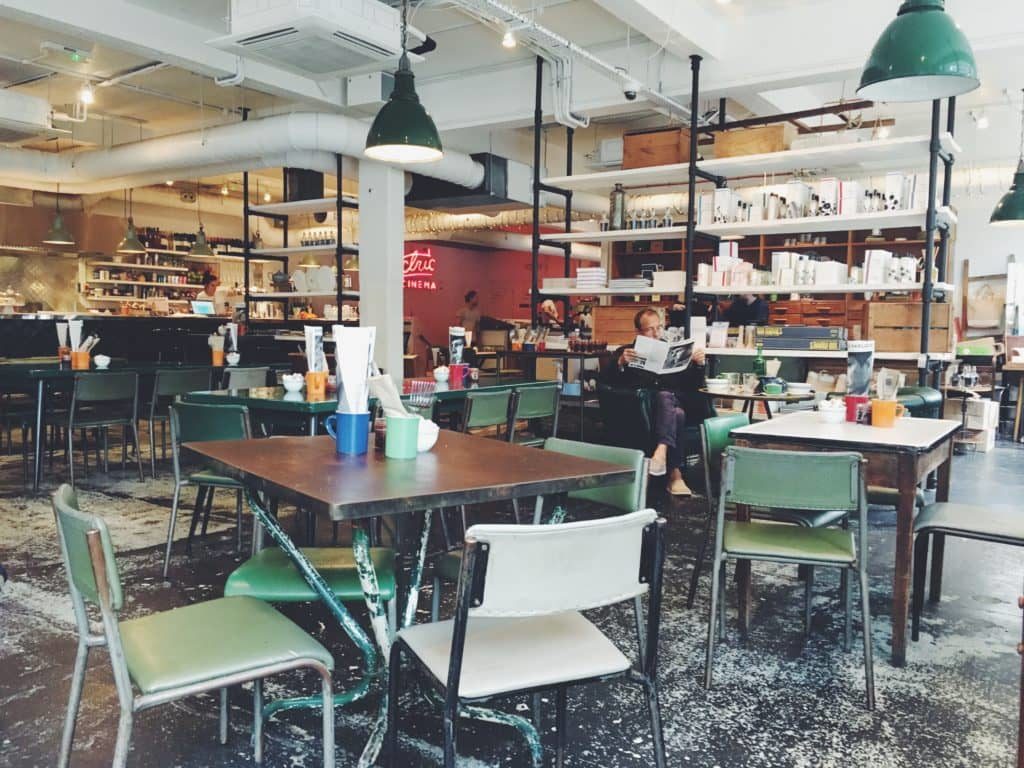
Upselling
Coffee is a high margin but low cost product. We’re being honest here, just selling coffee is often not financially wise. Most cafes need to raise the average “ticket price” of their customers to stay viable. You don’t need every customer to buy food, beans, or merchandise, but you need a number of them to. That’s why most coffee shops place their pastry/food case near the ordering station to make adding on food easy. Positioning other addon items like beans along the path to ordering is essential. As people walk in they are visually prompted by your additional offerings.
Plan to Open
Waiting until every minute detail is perfect will probably mean you’ll never get open. Things will be a little rough around the edges, but the sooner you can start getting customers through the door, the better. We recommend opening in 2-3 stages, starting with a soft open and ending with a grand opening.
Opening Party
Your opening party might be your soft open, or you may want to separate them out. At your opening party, you should invite friends and anyone who helped with your business at any stage as well as potential business partners and promoters. Expect to give out a lot of coffee to thank these people and get them talking about your shop. The opening party is also a great place to see how your bar flow is working with a more forgiving audience. Some things will likely need to be reworked, and that’s normal.
Soft Opening
A soft opening usually coincides with your opening party or comes shortly after when the wrinkles have been ironed out. This is the time to do a little marketing and a little promotion, to let business slowly start to build. There are still likely to be new issues and challenges to work out and this slower drip of customers helps really get your systems solidified.
Grand Opening
About two weeks after your soft opening, you will want to hold a grand opening. This is your big party with as much marketing and promotion as your can muster. Make sure everyone is ready to go and provide the best possible service.
After a grand opening, it’s normal to dip back down in customer count quite a bit. People are reluctant to change their routine. This dip is where your hard work on customer service and superior product will come in handy and the real marketing begins.
Develop Your Employees
Training new employees is a never ending responsibility that business owners can’t skimp on. By training employees well, you make sure they feel confident and ready to provide the experience you want customers to have.
When first training employees, it can be beneficial to run through exercises that emphasize efficiency. For example, give a new barista 4-5 drink orders and task them with making the drinks as quickly as possible without rushing. Allow new baristas extra time to think it over, and talk through the process with them. Come up with a few of these exercises (even better if you come up with them based on real life scenarios specific to you shop) and work through them. Be encouraging when the barista gets things right and gently correct by explaining the reasoning behind doing things a certain way. The more your baristas understand the “why” of things, the more you can trust them to make good decisions independently.
You can follow up with training by holding friendly contests among your staff or barista throwdowns with other cafes in the area. Baristas can compete on things like latte art, drink efficiency, and whatever else you might want. These should be fun above all else, and latte art throwdowns can be great publicity events.
Attempt to make training fun, but if your coffee shop takes off, you or your manager might not have time to train. As a business owner you stretch yourself incredibly thin, so we offer a way to pick up the slack. Online Barista Training is a learning platform accessible from any computer that cuts your training time down by up to 80%. We supply informative videos, instructions, and quizzes to educate baristas on all the fundamentals, so they can hit the ground running on the bar. Normal training might take 10 hours on the floor, with Online Barista Training it can take 2.
Grow Your Business
Menu
The most straightforward way to grow is having a menu with popular staples and rotating specials. When creating specials, consider seasonal flavors and unique combinations. In the age of social media, the visual appeal of a drink also can’t be understated. A drink that looks fun and iconic and tastes good is a better marketing tool than a drink that tastes amazing and looks normal. Of course, an amazing looking and tasting drink is ideal, but if you have to make a sacrifice, don’t take visual appeal for granted.
Your menu should also take into consideration what your customers want and where you’re located. If you have a lot of parents with kids, consider offering some kid friendly options. If you have a lot of busy business people, consider offering subscription services or refills in your branded mug to make their daily coffee trip as easy as possible for them.
Marketing for Coffee Shops
Marketing is a crucial part of owning a coffee shop that many business owners (understandably) don’t always devote enough time to. There are hundreds of ways to market your shop, but some are more useful than others.
Websites
Don’t try to get by without a website. A few businesses manage to do it, but they are the exception. You want a site that is above all easy to navigate. 90% of your visitors are there to see your menu, you address, your hours, or your contact information, so make those things easy to find. If you want to add more info about your story, staff, or anything else, do it! Having several pages on your site is generally a good idea, but you just need to make sure your most important info is easily accessible.
Social Media
Everyone wants a good social media presence, but how important is it to your specific business?
Do you have a lot of customers in their teens to mid 20s? An aesthetically pleasing instagram feed and a snapchat geotag are probably worthwhile investments.
Are your customers just a little older? Don’t neglect Instagram, but it doesn’t need to be as big of a focus. Instead, encourage customers to leave Google reviews and consider investing in some targeted paid advertising.
Are your customers middle aged and older? Maintaining your Facebook page becomes a little more important, and good service is a huge focus.
It’s important to try out different social media platforms and methods to see what sticks. A lot of baristas are younger and probably more invested and up to date with current social media, so ask for their opinions. If you have a barista who is particularly skilled at social media, let them take the reigns for a while. It’s a great experience and frees up your time a little.
Traditional Advertising
Are newspaper, radio, or TV ads worth it?
Maybe, it depends on your market. Newspaper ads are great for smaller, hyper local communities. Radio ads can be surprisingly effective among older demographics in a slightly wider range. The only avenue we seldom recommend is TV ads because of their expense. The other challenge with traditional advertising is that it can be difficult to track exactly how useful they are while digital ads can tell you exactly what your budget is returning.
Whatever marketing you do, consider asking customers what brought them in and regulars why they like coming back. Their answers are the best way to actually figure out what works. As you find your niche, reinvest even more into marketing.
Expanding
Opening another location sounds like it would be easier than opening your first location, but really it is just as complicated if not moreso. Unless your brand is incredibly strong, there’s no guarantee of success in one area leading to success in another. A bad expansion move can sink not just the new location, but the original location as well.
When looking to expand, it is vitally important to take the same steps as opening your first coffee shop. Finding a good location, doing market research, developing your menu, etc. are all steps that can’t be taken for granted. Also, consider that your time will now be split between two places. A good manager at each who can run things when you’re not there is paramount.
Coffee Roasting
Coffee roasting is a topic many coffee shop owners consider at one point or another. Roasting simultaneously has a lot of competition, yet a lot of room for growth. Much like the beer industry, more and more micro roasters are becoming popular, and home roasting has been on a steady incline. With that mind, we recommend business owners start small if at all. Roasting is an entirely different business model than running a coffee bar and can be a huge financial drain if not done carefully. We recommend waiting until at least your second year in business to consider expanding to roasting.
If you do decide to move into roasting, it can be a very rewarding field. The roast can affect so much about the coffee experience, and from a business perspective it can be a great way to diversify. A lot of coffee shops aren’t interested in moving into roasting, and that’s completely understandable. Roasting is only one way to grow your business, not the only way. That being said, Bellissimo’s roastery has been HIGHLY successful in getting our beans in the homes of people within the Pacific Northwest. Water Avenue coffee is the 2nd highest grossing roastery in the Portland area and we’re not slowing down – there’s good money to be made in roasting! (not to mention, you get to work directly with coffee farmers all over the globe).
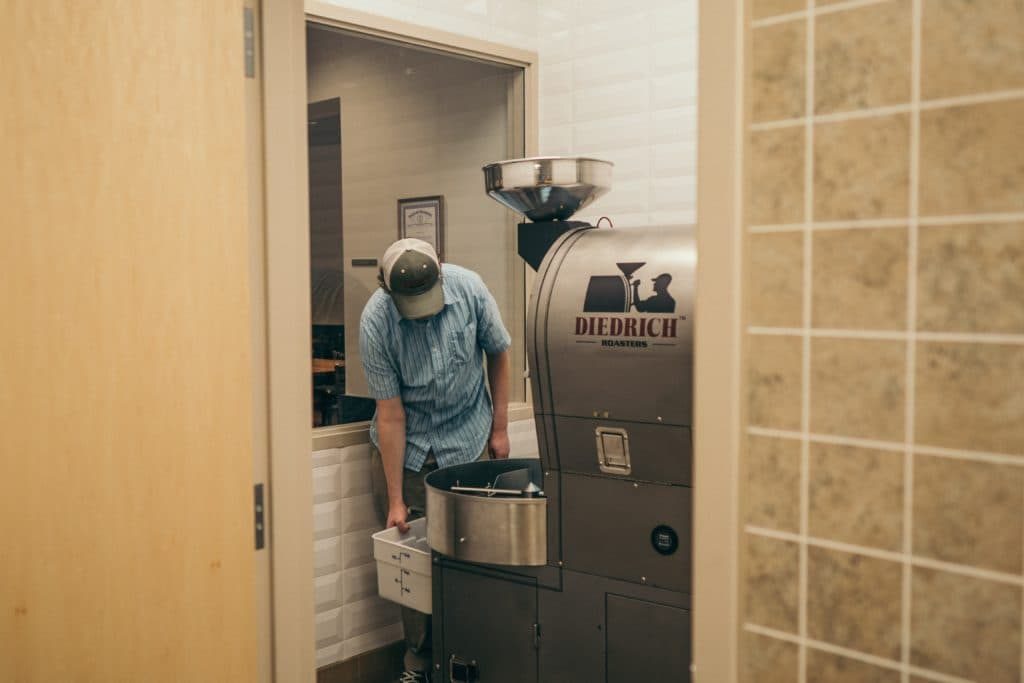
We see more and more people interested in roasting, so we offer a 1-day Intensive Roasting workshop where we teach you all about the roasting process and provide a good base for you to start exploring on your own or communicate with your local roaster more effectively. Whether for home or commercial roasting, learn all about the equipment and process behind coffee. (fun fact – most people are surprised to find out that light roast coffee has MORE caffeine in it than dark roast because it’s spent less time in the roaster, and thus, has had less of the caffeine cooked out of it!)
Conclusion
The coffee industry is a fascinating and rewarding place. Coffee professionals get to meet all kinds of people, and building your own space is a totally unique feeling. We hope this article is a great starting point for taking your first steps into this amazing industry. If you have any more questions, we have a variety of resources, workshops, and expertise to help you through any stage of owning your own business. Once again, we’re here to help.

